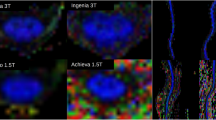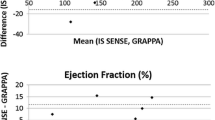Abstract
To compare the quality of cervical spine MR images obtained by parallel imaging [generalized autocalibrating partially parallel acquisition (GRAPPA)] with those of non-accelerated imaging, we conducted both phantom studies and examinations of ten volunteers at 1.5Tesla with a dedicated 12-element coil system and a head-spine-neck coil combination. Acquisitions included axial T2-weighted (T2w) images with both methods, and sagittal T2w and T1w images in vivo with the latter coil combination. Non-accelerated MRI with two averages and GRAPPA (acceleration factor 2) with two averages (GRAPPA/2AV, time reduction of approximately 50%) and four averages (GRAPPA/4AV) were compared. In the phantom, the signal-to-noise ratio of the GRAPPA/2AV was lower than that of the other two settings. In vivo, the image inhomogeneity (non-uniformity, NU) was significantly higher in T2w GRAPPA/2AV than in both other settings, and in T1w GRAPPA/2AV compared to GRAPPA/4AV. Subjectively, the delineation of anatomical structures was sufficient in all sequences. Only the spinal cord was considered to be better delineable on the non-accelerated T1w sequence compared to GRAPPA/2AV. In part, GRAPPA/4AV performed better than the other settings. The subjective image noise was lowest with GRAPPA/4AV. In cervical spine MRI, the examination time can be reduced by nearly 42% with GRAPPA, while preserving sufficient image quality.


Similar content being viewed by others
References
Sodickson DK, Manning WJ (1997) Simultaneous acquisition of spatial harmonics (SMASH): fast imaging with radiofrequency coil arrays. Magn Reson Med 38(4):591–603
Griswold MA, Jakob PM, Nittka M et al (2000) Partially parallel imaging with localized sensitivities (PILS). Magn Reson Med 44(4):602–609. DOI 10.1002/1522-2594(200010)44:4<602::AID-MRM14>3.0.CO;2-5
Griswold MA, Jakob PM, Heidemann RM et al (2002) Generalized autocalibrating partially parallel acquisitions (GRAPPA). Magn Reson Med 47(6):1202–1210. DOI 10.1002/mrm.10171
Jakob PM, Griswold MA, Edelman RR et al (1998) AUTO-SMASH: a self-calibrating technique for SMASH imaging. SiMultaneous Acquisition of Spatial Harmonics. Magma 7(1):42–54. DOI 10.1016/S1352-8661(98)00015-5
Katscher U, Börnert P, Leussler C et al (2003) Transmit SENSE. Magn Reson Med 49(1):144–150. DOI 10.1002/mrm.10353
Kurihara Y, Yakushiji YK, Tani I et al (2002) Coil sensitivity encoding in MR imaging: advantages and disadvantages in clinical practice. AJR Am J Roentgenol 178(5):1087–1091
Kyriakos WE, Panych LP, Kacher DF et al (2000) Sensitivity profiles from an array of coils for encoding and reconstruction in parallel (SPACE RIP). Magn Reson Med 44(2):301–308. DOI 10.1002/1522-2594(200008)44:2<301::AID-MRM18>3.0.CO;2-D
Madore B, Pelc NJ (2001) SMASH and SENSE: experimental and numerical comparisons. Magn Reson Med 45(6):1103–1111. DOI 10.1002/mrm.1145
Pruessmann KP, Weiger M, Scheidegger MB et al (1999) SENSE: sensitivity encoding for fast MRI. Magn Reson Med 42(5): 952–962. DOI 10.1002/(SICI)1522-2594(199911)42:5<952::AID-MRM16>3.0.CO;2-S
Sodickson DK, Griswold MA, Jakob PM et al (1999) Signal-to-noise ratio and signal-to-noise efficiency in SMASH imaging. Magn Reson Med 41(5): 1009–1022. DOI 10.1002/(SICI)1522-2594(199905)41:5<1009::AID-MRM21>3.0.CO;2-4
van den Brink JS, Watanabbe Y, Kuhl CK et al (2003) Implications of SENSE MR in routine clinical practice. Eur J Radiol 46(1): 3–27. DOI 10.1016/S0720-048X(02)00333-9
Weiger M, Pruessmann KP, Boesiger P (2002) 2D SENSE for faster 3D MRI. Magma 14(1):10–19. DOI 10.1016/S1352-8661(01)00152-1
Dietrich O, Nikolaou K, Wintersperger BJ et al (2002) iPAT: Applications for fast and cardiovaskular MRI. Electromedica 70(2):133–146
Heidemann RM, Özsarlak Ö, Parizel PM et al (2003) A brief review of parallel magnetic resonance imaging. Eur Radiol 13(10):2323–2337. DOI 10.1007/s00330-003-1992-7
Sodickson DK, McKenzie CA, Ohliger MA et al (2002) Recent advances in image reconstruction, coil sensitivity calibration, and coil array design for SMASH and generalized parallel MRI. Magma 13(3):158–163. DOI 10.1016/S1352-8661(01)00144-2
Firbank MJ, Coulthard A, Harrison RM et al (1999) A comparison of two methods for measuring the signal to noise ratio on MR images. Phys Med Biol 44(12):N261–N264. DOI 10.1088/0031-9155/44/12/403
Li T, Mirowitz SA (2002) Comparative study of fast MR imaging: quantitative analysis on image quality and efficiency among various time frames and contrast behaviours. Magn Reson Imaging 20(6):471–478. DOI 10.1016/S0730-725X(02)00527-1
Wicks DA, Barker GJ, Tofts PS (1993) Correction of intensity nonuniformity in MR images of any orientation. Magn Reson Imaging 11(2):183–196. DOI 10.1016/0730-725X(93)90023-7
Romaneehsen B, Oberholzer K, Müller LP et al (2003) Rapid musculoskeletal magnetic resonance imaging using integrated parallel acquisition techniques (IPAT) -initial experiences. Rofo 175(9):1193–1197. DOI 10.1055/s-2003-41926
Ross JS, Ruggieri P, Tkach J et al (1993) Lumbar degenerative disk disease: prospective comparison of conventional T2-weighted spin-echo imaging and T2-weighted rapid acquisition relaxation-enhanced imaging. AJNR 14(5):1215–1223
Schoonjans F (1993–1998) MedCalc, in Version 5.00.020 for Windows 95/98/NT
Ruel L, Brugieres P, Luciani A et al (2004) Comparison of in vitro and in vivo MRI of the spine using parallel imaging. AJR Am J Roentgenol 182(3):749–755
Dietrich O, Reeder SB, Reiser MF, Schoenberg SO (2005) Influence of parallel imaging and other reconstruction techniques on the measurement of signal-to-noise ratios. Proc Intern Soc Magn Reson Med (ISMRM) 13:158
Author information
Authors and Affiliations
Corresponding author
Rights and permissions
About this article
Cite this article
Noebauer-Huhmann, IM., Glaser, C., Dietrich, O. et al. MR imaging of the cervical spine: assessment of image quality with parallel imaging compared to non-accelerated MR measurements. Eur Radiol 17, 1147–1155 (2007). https://doi.org/10.1007/s00330-006-0411-2
Received:
Revised:
Accepted:
Published:
Issue Date:
DOI: https://doi.org/10.1007/s00330-006-0411-2




